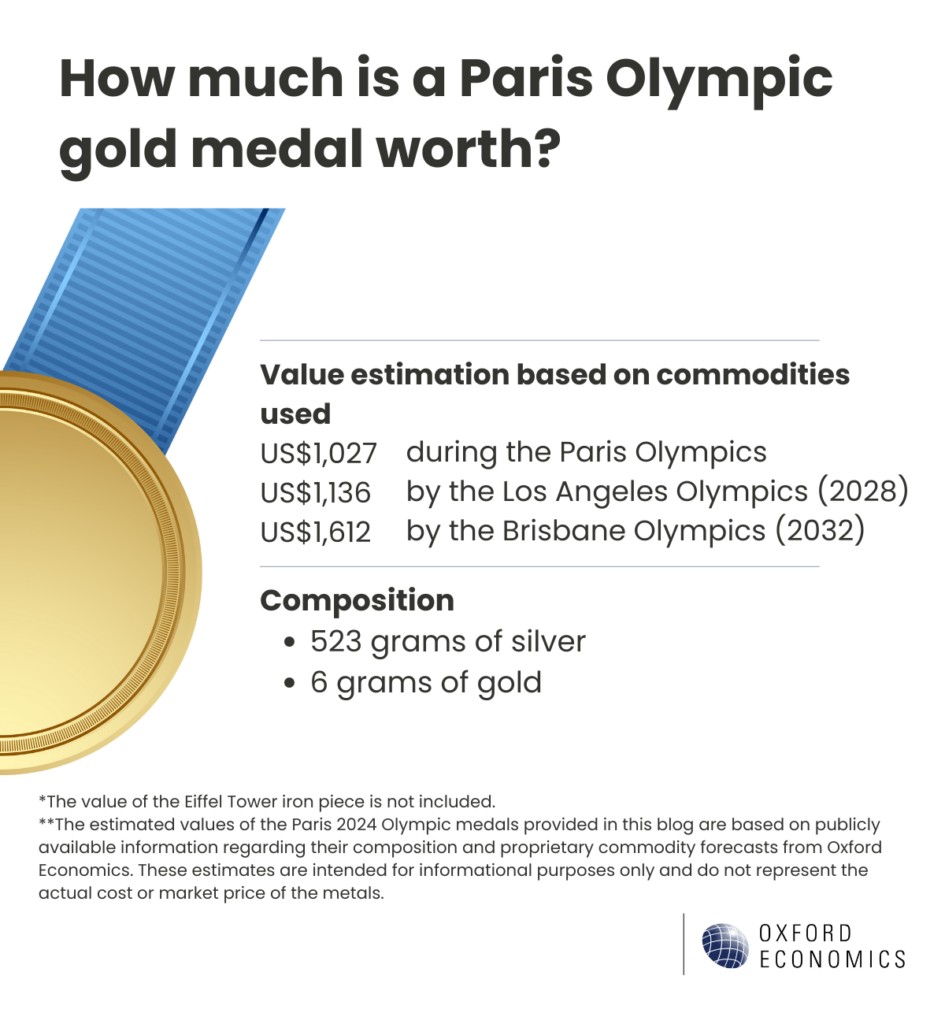Olympic gold medals, despite their prestigious name, aren’t solid gold. Curious about the composition and true worth of these coveted awards? At HOW.EDU.VN, our experts can provide comprehensive insights into the economics and material science behind the Olympic Games. Uncover the surprising details and explore the world of precious metals investment opportunities.
1. Composition of Olympic Medals: A Closer Look
While winning an Olympic gold medal represents the pinnacle of athletic achievement, its actual composition is more nuanced than pure gold. The International Olympic Committee (IOC) sets specific guidelines for the medals’ content.
- Gold Medals: Predominantly silver, plated with a thin layer of gold.
- Silver Medals: Made of nearly pure silver.
- Bronze Medals: Typically a copper alloy, often with small amounts of tin and zinc.
1.1. The 2024 Paris Olympics Medals: A Unique Twist
The 2024 Paris Olympics introduced a unique element to their medals. Each medal contains a piece of iron from the Eiffel Tower, blending historical significance with athletic achievement.
1.1.1. Composition Breakdown
- Gold Medals: 523 grams of silver coated with 6 grams of gold, plus the Eiffel Tower iron piece.
- Silver Medals: 525 grams of pure silver, plus the Eiffel Tower iron piece.
- Bronze Medals: 455 grams of copper, tin, and zinc alloy, plus the Eiffel Tower iron piece.
1.2. Historical Context
The practice of not using solid gold for Olympic gold medals dates back to the early 20th century. The last Olympic Games to award solid gold medals were the 1912 Stockholm Olympics. Since then, a gold-plated silver composition has been the standard.
2. The Value of Olympic Medals: Beyond the Metals
The true value of an Olympic medal extends far beyond its material worth. Factors such as the prestige, historical significance, and the athlete’s achievement contribute to its overall value.
2.1. Material Value
The material value can be calculated based on the current market prices of the metals used.
- Gold Medal (2024): Approximately US$1,027 (excluding the Eiffel Tower iron piece).
- Silver Medal (2024): Approximately US$535.
- Bronze Medal (2024): Approximately US$4.6.
2.2. Projected Value Increase
Experts predict that the value of these medals will increase over time due to rising precious and industrial metal prices.
- Gold Medal (2028): Estimated at US$1,136.
- Silver Medal (2028): Estimated at US$579.
- Bronze Medal (2028): Estimated at US$5.2.
- Gold Medal (2032): Estimated at US$1,612.
- Silver Medal (2032): Estimated at US$608.
- Bronze Medal (2032): Estimated at US$6.
2.3. Sentimental and Historical Value
The sentimental value of an Olympic medal to the athlete is immeasurable. It represents years of dedication, sacrifice, and hard work. The historical value also increases over time, especially if the athlete or the event becomes iconic.
3. Factors Influencing Metal Prices
Several factors influence the prices of gold, silver, copper, tin, and zinc, which in turn affect the value of Olympic medals.
3.1. Gold
Gold prices are influenced by:
- Central Bank Demand: Demand from central banks, particularly in emerging markets.
- Consumer Demand: Especially from countries like China.
- Economic Uncertainty: Gold is often seen as a safe-haven asset during economic downturns.
- Interest Rates: Lower interest rates tend to support higher gold prices.
3.2. Silver
Silver prices are influenced by:
- Industrial Demand: Silver has extensive industrial applications, including electronics and solar panels.
- Investment Demand: Investor sentiment and speculative trading.
- Economic Outlook: Brighter industrial production expectations can lead to higher silver prices.
3.3. Copper
Copper prices are influenced by:
- Industrial Production: Especially in China and other key regions.
- Electric Vehicle (EV) Production: Copper is a key component in EVs.
- Renewable Energy Projects: Copper is used extensively in renewable energy infrastructure.
- Mine Supply: New mine capacity and supply disruptions.
3.4. Zinc
Zinc prices are influenced by:
- Steel Production: Zinc is used to galvanize steel.
- Construction Activity: Construction is a major end-use market for zinc.
- Mine Supply: Zinc mining output and treatment charges.
3.5. Tin
Tin prices are influenced by:
- Electronics Sector: Tin is used in solder for electronics.
- Supply Disruptions: Disruptions in major tin-producing regions like Indonesia and Myanmar.
- Global Demand: Overall demand from the electronics and other sectors.
4. Expert Insights on Commodity Markets
At HOW.EDU.VN, our team of economists and commodity experts provides in-depth analysis and forecasts to help you understand market trends.
4.1. Gold Price Forecast
We anticipate gold prices to trade above US$2,640/oz by 2028 and US$2,865/oz by 2032. This forecast is based on strong structural demand forces, including central bank demand and Chinese consumer demand.
4.2. Silver Price Forecast
We expect silver prices to appreciate to US$31.27/oz by 2028 and US$32.83/oz by 2032, driven by a recovery in global industrial production.
4.3. Copper Price Forecast
We project copper prices will average US$11,051/tonne in 2028 and US$12,898 per tonne by 2032, driven by robust production of EVs and renewables.
4.4. Zinc Price Forecast
We forecast zinc prices to average US$2,863 in 2028, with demand linked to steel and construction activity.
4.5. Tin Price Forecast
We think tin prices will average US$33,834 per ton this year, driven by supply disruptions and demand from the electronics sector.
5. The Role of Commodities in the Global Economy
Commodities play a crucial role in the global economy, from crafting Olympic medals to building stadiums. Understanding the dynamics of these markets is essential for businesses and investors alike.
5.1. Metals in Infrastructure
Metals like copper, steel, and aluminum are used extensively in building infrastructure, including stadiums, transportation systems, and accommodation for athletes and spectators.
5.2. Precious Metals as Investments
Precious metals like gold and silver are often used as investments to hedge against inflation and economic uncertainty.
5.3. Industrial Metals in Manufacturing
Industrial metals like copper, zinc, and tin are essential components in manufacturing various products, from electronics to automobiles.
6. Consulting with Experts at HOW.EDU.VN
Navigating the complexities of commodity markets requires expert knowledge and insights. At HOW.EDU.VN, we connect you with leading PhDs and experts who can provide personalized guidance.
6.1. Access to Leading Experts
Our platform provides access to over 100 renowned PhDs and specialists in various fields, including economics, finance, and material science.
6.2. Personalized Consultations
We offer personalized consultations tailored to your specific needs, whether you’re an investor, a business owner, or simply curious about the world of commodities.
6.3. Timely and Reliable Advice
Our experts provide timely and reliable advice based on the latest market trends and economic data.
6.4. Secure and Confidential Consultations
We ensure the confidentiality and security of your consultations, so you can discuss your concerns with peace of mind.
6.5. How to Get Started
- Visit our website at HOW.EDU.VN.
- Browse our directory of experts.
- Select an expert whose expertise matches your needs.
- Schedule a consultation.
- Get personalized advice and insights.
7. Why Choose HOW.EDU.VN?
Choosing HOW.EDU.VN for your expert consultation needs offers several distinct advantages.
7.1. Expertise and Experience
Our team consists of seasoned professionals with extensive experience in their respective fields.
7.2. Global Network
We have a global network of experts, providing diverse perspectives and insights.
7.3. Customized Solutions
We tailor our solutions to meet your specific needs and objectives.
7.4. Proven Track Record
We have a proven track record of helping clients achieve their goals.
7.5. Commitment to Excellence
We are committed to providing the highest level of service and expertise.
8. Understanding Search Intent
Understanding the search intent behind “How Much Gold In Olympic Medal” is crucial for providing relevant and valuable content. Here are five key search intents:
- Informational: Users want to know the actual composition of Olympic gold medals.
- Educational: Users seek detailed explanations about the materials used and why solid gold isn’t used.
- Economic: Users are interested in the market value of the metals in the medals.
- Historical: Users want to understand the history and evolution of Olympic medal composition.
- Investment: Users explore the investment potential and future value of the medals.
9. Addressing Client Challenges
Many individuals face challenges in accessing reliable expert advice. HOW.EDU.VN addresses these challenges by:
9.1. Connecting with Qualified Experts
We connect you directly with qualified PhDs and experts in various fields.
9.2. Providing Cost-Effective Solutions
Our consultation services are designed to be cost-effective, saving you time and money.
9.3. Ensuring Confidentiality and Trust
We prioritize the confidentiality and trust of our clients.
9.4. Offering Practical Solutions
Our experts provide practical solutions that you can implement immediately.
10. Frequently Asked Questions (FAQ)
10.1. Are Olympic gold medals made of solid gold?
No, Olympic gold medals are primarily made of silver and plated with a thin layer of gold.
10.2. Why aren’t Olympic gold medals made of solid gold?
Using solid gold would be prohibitively expensive. The current composition balances prestige with cost-effectiveness.
10.3. What is the approximate material value of a 2024 Olympic gold medal?
Approximately US$1,027, excluding the Eiffel Tower iron piece.
10.4. How much does a silver medal cost?
Approximately US$535.
10.5. What are the main factors that influence gold prices?
Central bank demand, consumer demand, economic uncertainty, and interest rates.
10.6. How do I get in touch with an expert at HOW.EDU.VN?
Visit our website at HOW.EDU.VN, browse our directory of experts, and schedule a consultation.
10.7. What types of expertise are available at HOW.EDU.VN?
We offer expertise in various fields, including economics, finance, material science, and more.
10.8. Is my consultation confidential?
Yes, we ensure the confidentiality and security of all consultations.
10.9. Can I get personalized advice tailored to my specific needs?
Yes, our experts provide personalized consultations tailored to your specific needs.
10.10. What makes HOW.EDU.VN different from other expert consultation platforms?
Our access to leading PhDs, global network, customized solutions, and commitment to excellence set us apart.
11. Call to Action
Ready to gain expert insights and solve your challenges? Contact HOW.EDU.VN today to schedule a consultation with our leading PhDs and experts. Whether you need advice on commodity markets, investment strategies, or any other complex issue, we’re here to help.
Address: 456 Expertise Plaza, Consult City, CA 90210, United States
WhatsApp: +1 (310) 555-1212
Website: HOW.EDU.VN
Don’t navigate complex issues alone. Let the experts at how.edu.vn guide you to success.


